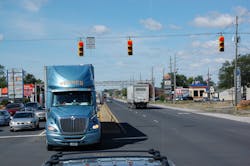Trucking executives are exploring any number of ways to help them solve the burgeoning driver shortage – and are casting their nets wider and wider for help.
During a variety of panel discussions and presentations at the annual FTR Transportation Conference in Indianapolis this week, executives from large and small carriers alike from across the industry’s many different segments offered up their thoughts on this thorny issue in trucking’s side.
“Clearly the problem of the driver shortage only going to get worse; the demographics are shrinking and total labor pool is smaller,” noted Derek Leathers, president and COO of Werner Enterprises, based in Omaha, NE, which employs some 9,000 drivers.
“So we’re spending a tremendous amount of thought on this problem: not only on pay and providing a great truck to drive, but the importance of the day-to-day terminal network – and that depends on the customer,” he stressed. “Our trucks have wheels and we’ll roll them to the customer that supports us.”
Leathers added that Werner is now “pricing for shipper practices” and will in some cases walk away from business if it impacts the company's drivers too much.
“We recognize turnover at an account level now,” he said. “We simply cannot afford to put drivers in a situation where we’ll lose him or her over shipper practices.”
And shippers thinking that a switch to rail-based intermodal from trucks will eliminate the need to adapt their practices should think again, warned Larry Gross, FTR’s senior consultant and resident rail/intermodal freight expert.
“To the extent that intermodal is being cast as a solution to the driver crisis: my message is, forget it,” he said. “The total conversion potential [of moving freight from truck to rail] is about 2% of total trucking.”
Gross added that intermodal is having a much harder time breaking into lower lengths of haul because of low fuel prices, still-adequate truck capacity and rail service issues. Thus the average length of haul in the intermodal space remains around 1,400 miles, he noted.
Gross also pointed out that “sometimes folks tend to forget that every intermodal move involves a truck on each end” and that drivers are getting just as scarce in the drayage sector as everywhere else in trucking – and for many of the same reasons.
“We’re losing drivers not only to other drayage carriers but to other [trucking] sectors such as final mile delivery,” noted Ken Kellaway, president and CEO of RoadOne Intermodal Logistics. “We’re still one of the lower paid sectors in the transportation space [and] we’ve got to figure out how to make that up.”
Kellaway thinks the drayage segment needs 20,000-plus drivers to get back to where it needs to be in order to be fully efficient.
“Drayage is the thing everybody has to watch out for,” he urged. “We’ve got to get drayage stabilized.”
The problem is also a cultural one, stressed James Burg, president and CEO of James Burg Trucking – a heavy-haul 90-tractor flatbed fleet out of Detroit, MI.
“I started driving trucks when I was 17 and you cannot do that anymore due to regulations and our litigious society,” he said. “We do have to figure out a way to develop [truck driver] apprenticeships, because we are not even allowed to have ‘ride alongs’ in our trucks. We cannot even allow children of our drivers to be with them in their cabs to see what their dad does for a living.”
Even specialty operations, such as chemical haulers, are trying to change things up to make their truck driving jobs more appealing.
“Economics are a big piece, of course, but home time and work schedule predictability is our focus,” explained Randy Strutz, president of quality control for Florida-based Quality Carriers, which employs 2,500 drivers and operates a fleet of 6,000 tanker trailers.
“We’re now trying to change our business model: now we start our planning with the idea of getting a driver home every night. That means more relay systems in some of lanes,” he said. “But truck driving is not the easiest of jobs and ours especially hard. Our drivers are wearing hazmat suits on 90 degree days in Houston, or working outside in temperatures down to minus 10 in Chicago dragging 60 feet of hose.”
Yet Kevin Tomlinson, director of maintenance for South Shore Transportation Co., hoped that the sheer demand for truck drivers and its rising pay scales should at some get attention of John Q. Public.
“We are an industry out there striving to find employees; we are almost hiring anyone we can get a hold of,” he said. “There are not many industries doing that these days.”
About the Author
Sean Kilcarr
Editor in Chief
Sean Kilcarr is a former longtime FleetOwner senior editor who wrote for the publication from 2000 to 2018. He served as editor-in-chief from 2017 to 2018.
